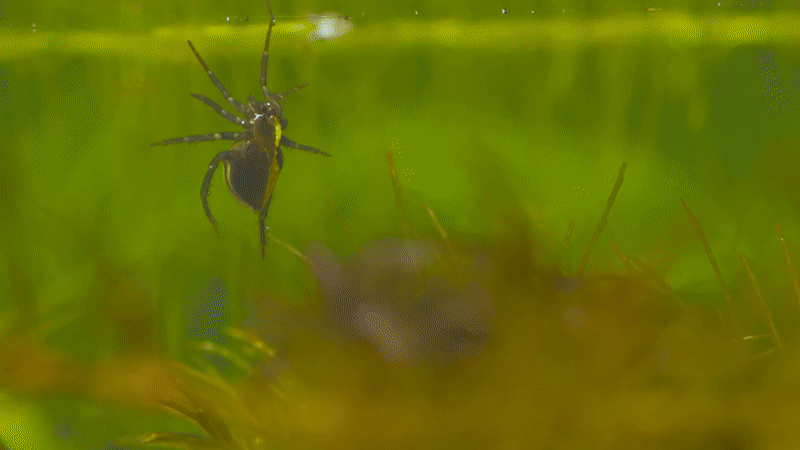A fish caught in a spider’s web? There’s clearly something wrong with this photo. Did the fish jump ashore or did the spider dive into the water, spin its webs and improve its meal?
The second possibility seems to be higher. Because in this photo, we see that what spider silk clings to is the stalks of aquatic plants. And if you pay close attention, you will also see that the spider has built itself a bubble house underwater.

What could be more surprising than a spider (which has no gills to breathe underwater) but still lives, hunts, even mates and reproduces underwater? In this article we will learn about how Argyroneta aquatica – the strangest spider on the planet does it.
The diving art of the spider Argyroneta aquatica
For the average spider, falling into the water could mean death. It will quickly suffer from hypothermia, lack of air and even become prey for aquatic species.
But with the species A. aquatica, also known as “bell diving spider“, underwater is its preferred habitat.
First of all, let’s talk about the name, why the bell diving spider? That’s because the creature has mimicked a human diving technique (or maybe humans copied them – Who knows?):
As far back as the 4th century BC, Aristotle described how divers dropped a bell into the water, trapping the air in it to serve as a breathing station when undertaking underwater exploration.

Alexander the Great himself (356 BC -323 BC), Aristotle’s great student, also used a glass bell to dive during his oceanic expeditions.
He also brought a dog, a cat and a rooster on this special journey – animals that were fortunate to become the first representatives of their species to dive to the bottom of the sea.
Going back to the A. aquatica spiders, they don’t have to follow Alexander the Great to explore the underwater world. Because this spider can make its own diving bells.
The clever strategy of spider A. aquatica is implemented as follows:

First, it will dive into the water and find some aquatic tree branches to spin silk on. But instead of spreading its web across a flat surface like other spiders, A. aquatica will wind its web layer by layer like a 3D printer, to create an upside-down silk bell under water.
Then, the spider swam back to the surface, continuing to spin silk to form a ladder connecting the bell below and the water above. The next step is to transport air from the surface of the water and pour it into the bell below.
What do you think the spider A. aquatica would do? Will it fill its lungs with air, then dive into the bell and blow it out?
No! The spider A. aquatica has a much more refined and effective strategy. To get air, it simply props its furry butt in the air, then quickly dips it in the water:

At this point, hydrophobic hairs protrude from its abdomen and body, trapping a layer of surrounding air in. Taking advantage of the limited surface tension of water, the spider will create a shiny silver air bubble around itself.
Then it just tries to dive back into the bell like a child in a life jacket, and releases the air bubble. After several dives like this, the spider A. aquatica was able to fill its bell with air.
Now, it officially has an underwater home.
The bell diving spider (Argyroneta aquatica) is an aquatic spider
The diving bell spider can stay underwater all day, because its house has the function of sucking oxygen from the water
It is proof that A. aquatica is not just a diver, it is an engineer. Previously, scientists thought that the diving bells of the spider A. aquatica could only supply enough oxygen for it to function for half an hour at most.
That is, about every 20 minutes, the spider A. aquatica will have to come to the surface and breathe, and carry a new load of oxygen down to its home.
But as it turned out, the scientists were wrong.
In 2014, biologist Roger Seymour at the University of Adelaide, Australia did a close study of the behavior of A. aquatica spiders and found: They can actually stay underwater all day.

The silk bell of the spider A. aquatica has the function of exchanging oxygen with water like the gills of a fish.
Seymour explains that the reason comes from the silk bell, which itself functions to exchange oxygen with water like the gills of a fish. “Because the bubble in the diving bell is held only by spider silk, most of its area is an interface between water and air and the thin silk filaments.” Seymour said.
“And this allows oxygen to be exchanged between the water and the bubble.” The same process happens with the CO2 that the spider exhales. Gases simply diffuse from an area of high concentration to an area of low concentration.
So when the bell has more CO2 and less oxygen, it will take its own oxygen from the water and diffuse the CO2 back. “This mechanism can deliver an amount of oxygen through the silk wall 8 times more than the amount a spider can transport down from the surface of the water.“, Seymour said.
An A. aquatica spider can therefore stay underwater all day.

And what are they doing down there… all day?
Of course, a spider will spend most of its life spinning, trapping, and waiting for its prey. The spider A. aquatica itself is a mighty underwater hunter. It also has enough venom to take down small fish and crustaceans entangled in its web.
Normally, A. aquatica spiders will set traps around aquatic plants near their diving bells. These spiders then simply dip their butts into the diving bell and poke their faces out to observe.
In case you don’t know, spiders breathe through spiracles located on the sides of the chest and abdomen called “book lungs” (because they open and fold like the pages of a book).
They have windpipes that carry oxygen straight into tissues and organs without going through the head. Thus, the spider A. aquatica can stick its belly into its bell and breathe, while keeping its head out of the water to see its prey.
The diving bell spider (Argyroneta aquatica) hunts underwater
When it sees a trapped prey, A. aquatica spider will run out of the bell, knocking it down with a painful bite. After that, the spider will climb to the surface of the water and carry an extra amount of air down to expand its house, enough to accommodate a large dining table.
After all the preparations are complete, the new spider drags its meal into the bell and begins to slaughter the aquatic species. On dreary days and without trapping large prey, A. aquatica spiders will nibble on aquatic larvae as their snacks.
Having a home and having enough to eat, let’s find a mate and reproduce
Such is the elegant life of the bell diving spider. One difference between this spider and other terrestrial spiders is that the females of A. aquatica are usually smaller than the males. Normally, female spiders will have to be larger than male spiders because they need to accumulate nutrients to lay eggs and take care of young.
But also for the purpose of laying eggs and raising young, the female spider A. aquatica is smaller than the male spider. That’s because this spider lays eggs and raises their young in the water. The smaller female spider’s size also means she will have more room to lay and more space for her cubs, in her tight bell.

Male spiders A. aquatica – conversely – are those that must swim in the water to find the female spider. It therefore requires a larger body to swim stronger. When the male spider A. aquatica discovers a bell of the female spider, it begins to build another bell”neighbor” next to her to start flirting with her.
Once the bell is complete, and the female spider has gotten used to her neighbor’s presence, the male A. aquatica will carve a path from his new bell to the female’s house.
The two spiders will mate with each other. And after each such mating, female A. aquatica will lay 30-70 eggs. The hatched eggs will become baby spiders and they will begin to be trained for their aquatic life.
The diving bell spider (Argyroneta aquatica) conquers its mates underwater
After just a few weeks, the young A. aquatica spiders are ready to separate from their mothers. They will again learn how to build diving bells, rise to the surface and carry air down to make their own houses.
Just like that, the life and lineage of the diving bell spider continued to develop. They are conquering freshwater areas across Europe and Asia. So the next time you see a silver spider in the water that refuses to stay in a tree and prefers to dive and fish, remember it’s the bell diving spider Argyroneta aquatica – a venomous spider. unique on the planet.
Synthetic
